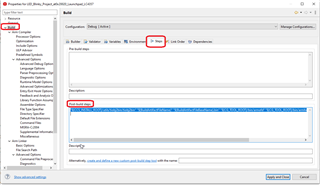Other Parts Discussed in Thread: UNIFLASH
Tool/software:
The compiler version is TI v20.2.7.LTS.
After outputting the .out file to a .bin file, when I burn the .bin file to the chip using UniFlash, the firmware does not work properly.
Start analyzing the contents of the bin file:
The ArmHex tool outputs the following relevant parameters for the bin file:
--fill=0xFF --map="xxx.map" --romwidth=32 --diag_wrap=off --binary -o "xxx.bin" "xxx.out"
Add an output mapflie to analyze bin file composition.
Then use the UniFlash tool to burn the.out file to the chip, and then export the flash content and save it as a.bin file. Compare two files using the file comparison tool:
The address of the first difference between the two files here is 0x003b304, and the difference content is as shown in the following figure:

In the preceding figure, the contents of the bin file that can be exported from the flash are on the left, and the contents of the bin file generated by the ArmHex tool are on the right.
Compare the.bin map file with the.out map file.
==================================================================================
.out mapfile:
SEGMENT ALLOCATION MAP
run origin load origin length init length attrs members
---------- ----------- ---------- ----------- ----- -------
00000000 00000000 0003b304 0003b304 r-x
00000000 00000000 00000020 00000020 r-x .intvecs
00000020 00000020 00000100 00000100 r-- section_image_header
00000120 00000120 0003b1e4 0003b1e4 r-x .text
0003b320 0003b320 000027d4 000027d4 r--
0003b320 0003b320 000027d4 000027d4 r-- .const
0003db00 0003db00 00000618 00000618 r--
0003db00 0003db00 00000618 00000618 r-- __param
0003e120 0003e120 00000048 00000048 r--
0003e120 0003e120 00000048 00000048 r-- clisection
0003e180 0003e180 000002b8 000002b8 r--
0003e180 0003e180 000002b8 000002b8 r-- .cinit
08010000 08010000 0002c638 00000000 rw-
08010000 08010000 0001a8c0 00000000 rw- .bss
0802a8c0 0802a8c0 00009d76 00000000 rw- .data
08034638 08034638 00008000 00000000 rw- .sysmem
==================================================================================
.bin mapfile:
OUTPUT TRANSLATION MAP
--------------------------------------------------------------------------------
00000000..ffffffff Page=0 Memory Width=8 ROM Width=8
--------------------------------------------------------------------------------
OUTPUT FILES: xxx.bin [b0..b7]
CONTENTS: 00000000..0000001f xxx.out(.intvecs)
00000020..0000011f xxx.out(section_image_header)
00000120..0003b303 xxx.out(.text)
0003b320..0003daf3 xxx.out(.const)
0003db00..0003e117 xxx.out(__param)
0003e120..0003e167 xxx.out(clisection)
0003e180..0003e437 xxx.out(.cinit)
From both map files, you can see that the address of the.text field is 0x00000120 to 0x0003b303, and the address of the following.const field is 0x0003b320 to 0x0003daf3.
The description of the two map files is the same, which means that the range of addresses 0x0003b304 to 0x0003b31 should be filled with 0xFF or other useless data.
However, in the actual bin file content, it can be found that the content of the.const field in the bin file generated by the ArmHex file is continuously written to the address 0x0003b304, resulting in all subsequent content generated the address dislocation.
Therefore, the bin file generated by ArmHex cannot correspond to the mapfile output by oneself and cannot run properly.
I need to provide some technical support to help me solve this problem.



